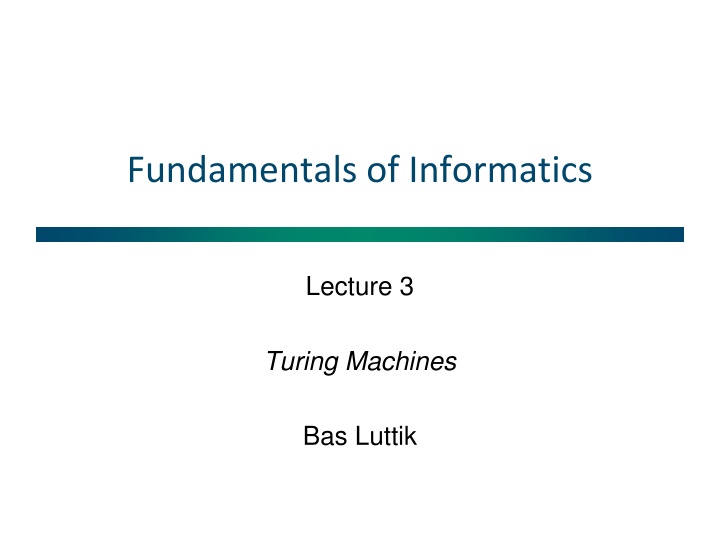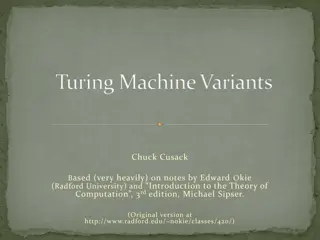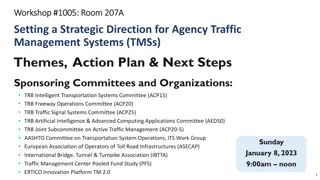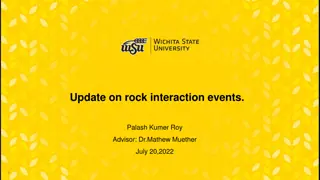
Turing Machines and Regular Languages Explained
Explore the concepts of Turing Machines, regular expressions, Kleene's theorem, and regular languages in informatics. Understand the significance of finite automata in modeling computers and the essence of computation as elucidated by Alan Turing.
Download Presentation

Please find below an Image/Link to download the presentation.
The content on the website is provided AS IS for your information and personal use only. It may not be sold, licensed, or shared on other websites without obtaining consent from the author. If you encounter any issues during the download, it is possible that the publisher has removed the file from their server.
You are allowed to download the files provided on this website for personal or commercial use, subject to the condition that they are used lawfully. All files are the property of their respective owners.
The content on the website is provided AS IS for your information and personal use only. It may not be sold, licensed, or shared on other websites without obtaining consent from the author.
E N D
Presentation Transcript
Fundamentals of Informatics Lecture 3 Turing Machines Bas Luttik
Example regular expressions Give regular expressions for the language consisting of all sequences over a, b containing the pattern aa: (a+b)*(aa)(a+b)* 1. all sequences over a, b with an even number of b s: a*(ba*ba*)* 2. all sequences over a, b with an odd number of b s: a*ba*(ba*ba*)* 3. all sequences over a, b, with an even number of b s that contain the pattern aa: a*(ba*ba*)*(aa)a*(ba*ba*)* + a*ba*(ba*ba*)*(aa)a*ba*(ba*ba*)* 4.
Kleenes theorem (1956) There is a direct correspondence between the languages described by a regular expression, and those accepted by a finite automaton: every language described by a regular expression is accepted by some finite automaton and, moreover, every language accepted by a finite automaton is described by a regular expression Stephen Kleene (1909-1994) Disclaimer: for this result it is necessary to add symbols and denoting the empty language and the language containing the empty string to the language of regular expressions; we left them out for simplicity.
Regular languages Languages accepted by a finite automaton (or, equivalently: described by a regular expression) are called regular. Fundamental question: Is every language regular? Consider, e.g., the language of marked palindromes consisting of all sequences of the shape sms-1 in which s is a sequence of symbols, m is a special marker symbol and s-1 is the reverse of s. There is no finite automaton that accepts the language of marked palindromes. So, the answer to the above fundamental questions is: NO!
Computer (mathematical model) Can we model a computer as a finite automaton? Any particular computer has a finite amount of memory and therefore has finitely many states. But there is no intrinsic bound on the number of states. Therefore, finite automata are unsatisfactory as mathematical model if our goal is to predict which type of problems can be solved with a computer. Let s analyze what it means to compute! (as Alan Turing did back in 1936)
The essence of computation A person carrying out a computation operates under the following constraints: 4231 77 x at each stage only a small number of symbols receive attention; 29617 296170+ 325787 action at each stage depends on symbols receiving attention, and current state of mind of person Alan Turing (1912-1954) 4 2 3 1 x 7 7 = 7 (remember 2) 7 1 4 2 3 1 x 7 7 = 2 9 6 1 7 + 2 9 6 1 7 0 = 7 4 2 3 1 x 7 7 = 2 9 6 1 7 + 2 9 6 1 7 0 = 3 2 5 7 8 7
Computation (down to bare minimum) How large should the alphabet of symbols be? finitely many How many symbols should be observed simultaneously in a computation? one is enough! How many states of mind? finitely many Turing s conclusion in 1936, after careful analysis: computation is carried out by writing symbols in squares on a tape; at each step the person performing the computation pays attention to the symbol written in exactly one of these squares; her next action depends only on this symbol and her state of mind; this next action consists of writing a new symbol on the square and shifting attention to square immediately to the left or right.
Turing machine (conceptual) A Turing machine is an automaton consisting of: a finite control; a finite alphabet of tape symbols a two-way infinite tape subdivided into squares each square contains a symbol or is blank (in diagrams we use the symbol to denote a blank square) a read/write head that scans the contents of one square at a time and can move left or right.
Turing machine (definition) A Turing machine consists of 1. A finite collection of states exactly one of these states is marked to be the initial state some states are so-called halting states 2. A finite alphabet of tape symbols including a special symbol 3. A transition table determining for every combination of a non- halting current state and scanned tape symbol: a new tape symbol (to be written on the position of the scanned tape symbol), a direction of movement of the tape head (L or R), and a next current state.
Example current state symbol scanned symbol written next state 1. states: q, h motion initial state: q q 0 1 R q q 1 0 R q halting states: h q L h 2. tape symbols: 0, 1, 3. transition table: We prefer to present a Turing machine as a state-transition diagram: Transitions in a state-transition diagram for a Turing machine are labeled with triples consisting of 0 1 R 1 0 R <symbol scanned> <symbol written> <motion> L h q For clarity, we may depict halting states with a double circle (but we sometimes forget!)
Turing machine: computation A computation of a Turing machine starts in the initial state, with some input sequence of symbols on the tape and the tape head on the left- most symbol of the sequence (if it is non-empty). The machine then repeatedly performs the following operation, until it enters a halting state: on the basis of the current state and the scanned tape symbol it looks up the corresponding row in the table, carries out the appropriate actions (write new symbol, move the tape head), and enters the next state. We assume that the input sequence is either the empty sequence, or a non-empty sequence of non-blank symbols written consecutively on the tape. The sequence that is found on the tape after the computation has halted is its output sequence.
Exercise Consider the following Turing machine: 0 1 R 1 0 R L h q Determine the result of the computation of this Turing machine: input sequence 11 001 10101 output sequence 00 110 01010 This Turing machine inverts binary sequences.
Constructing Turing machines Example Construct a Turing machine that multiplies a binary number by 2: 0 0 R 1 1 R 0 L q h
Example TM: (unary) multiplication An L (or an R) in a state means: go left (or right) after writing the scanned symbol and stay in the same state, unless there is an outgoing arrow with the scanned symbol. Example The following Turing machine performs multiplication of unary numbers (e.g., on the input sequence 111x11 it yields the output sequence 111111). *R L R L L L 11L 1 L xxL L L 1R * * R x L L xxL * L R L R 1 L 11R
Want to see more? There are many Turing machine simulators available online, for instance, at http://morphett.info/turing/turing.html
Computations may not terminate Exercise Design a Turing machine that, when started with a non-empty sequence of 0s and 1s on the tape, has a terminating computation only if the binary input sequence on the tape represents an even number: 0 0 R 1 1 R 0 0 R L 1 1 R R 0 0 R 1 1 R R
Turing machines as language acceptors The language of a Turing machine is the collection of all input sequences on which it halts.
Exercise R q0 h a a R a a R a R L L q1 l Question: Which language does it accept? Answer: It accepts the language (aa)*.
Turing machines as language acceptors The language of a Turing machine is the collection of all input sequences on which it halts. It is straightforward to convert a finite automaton into a Turing machine that accepts precisely the same language: for every input symbol a, replace every transition with label a of the finite automaton by a transition with label a a R ; add from every accepting state of the finite automaton a transition with label R to a new halting state; add from every non-accepting state of the finite automaton a transition with label R to a new state; this new state has, moreover, transitions with labels a a R for every input symbol and a transition with label R How about the converse? Is every language of a Turing machine accepted by some finite automaton?
Marked palindromes Exercise Design a Turing machine that accepts the language of marked palindromes (sms-1 with s a sequence of 0s and 1s, and s-1 its reverse). 0 L L R 1 1 R 0 0 R m m R 0 R 1 1 R R m m R R m m R L L R 0 0 R m m R R R 1 R L R 1 L
Marked palindromes Exercise Design a Turing machine that accepts the language of marked palindromes (sms-1 with s a sequence of 0s and 1s, and s-1 its reverse). 0 L L R 1 1 R 0 0 R m m R 0 R 1 1 R R m m R R m m R L L R 0 0 R m m R R R 1 R L R 1 L
Robustness (example 1) We could modify the definition of Turing machines by adding a third type of motion for the tape head: We mean to express that there is a transition for every symbol in the alphabet of the Turing machine that writes the same symbol back and causes the tape head to move left. S for stay at the current position Question: Are Turing machines with an additional S motion for the tape head more powerful than Turing machines with only the motions L and R? Answer: No. We can always transform a Turing machine with S motions to one without S motions, by replacing x y S x y R ? ? L by The resulting Turing machine computes/accepts the same.
Robustness (example 2) We could (further) modify the definition of Turing machines by having two (or more) tapes. An entry in the transition table would then look like: symbol scanned (tape 1) symbol written (tape 1) symbol scanned (tape 2) symbol written (tape 2) current state motion (tape 1) motion (tape 2) next state q0 a c L d L q1 Question: Are Turing machines with two tapes more powerful than Turing machines with one tape? Answer: No. We can always transform a Turing machine with two tapes to one with one tape computing/accepting the same (see Ch.31 of NTO).
Robustness Turing machines do not get fundamentally more (or less) powerful if we: allow multiple tapes allow multi-dimensional tapes allow tapes that are bounded on one side allow non-determinism restrict the alphabet of tape symbols Moreover, every other (realistic) mathematical model of computation conceived so far can be simulated with a Turing machine, and hence is not more powerful.
Turing power As language acceptors Turing machines are (far) more powerful than finite automata (e.g., there exists a Turing machine that accepts the language of marked palindromes, for which there is no finite automaton) As computational devices, Turing machines have clearly delineated the fundamental limits of computation: everything that can be computed (now and in the future), can be computed by some Turing machine Disclaimer: This is not to say that a Turing machine can do everything a computer can do. For instance, computers can interact with their environment, which (conventional) Turing machines can t.
Material Reading material for this lecture: Chapter 31: Turing Machines (see reader) (Slides and practice material can be found in OASE.) Deviations from text in reader: Chapter 31 specifies a Turing machine as a collection of quintuples, instead of with a transition table; the difference is only cosmetic. Chapter 31 uses the symbol b for blank; we prefer . Chapter 31 mentions, besides L and R, also an S-motion for the tape head. It is not needed (as we have seen), we shall not use it, and therefore we left it out from our definition.











